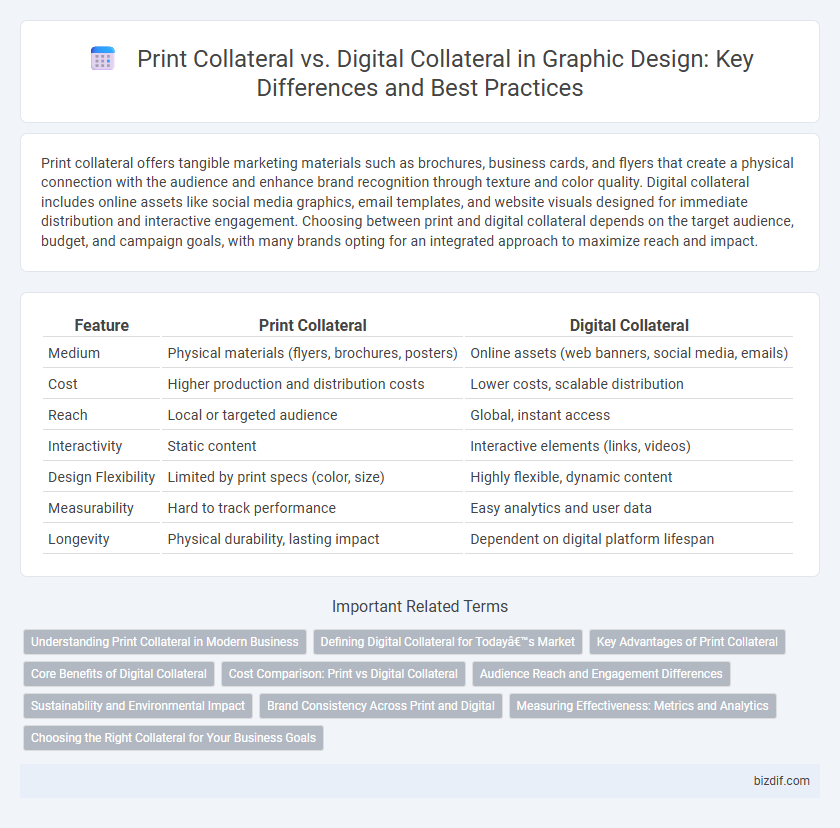Print collateral offers tangible marketing materials such as brochures, business cards, and flyers that create a physical connection with the audience and enhance brand recognition through texture and color quality. Digital collateral includes online assets like social media graphics, email templates, and website visuals designed for immediate distribution and interactive engagement. Choosing between print and digital collateral depends on the target audience, budget, and campaign goals, with many brands opting for an integrated approach to maximize reach and impact.
Table of Comparison
| Feature | Print Collateral | Digital Collateral |
|---|---|---|
| Medium | Physical materials (flyers, brochures, posters) | Online assets (web banners, social media, emails) |
| Cost | Higher production and distribution costs | Lower costs, scalable distribution |
| Reach | Local or targeted audience | Global, instant access |
| Interactivity | Static content | Interactive elements (links, videos) |
| Design Flexibility | Limited by print specs (color, size) | Highly flexible, dynamic content |
| Measurability | Hard to track performance | Easy analytics and user data |
| Longevity | Physical durability, lasting impact | Dependent on digital platform lifespan |
Understanding Print Collateral in Modern Business
Print collateral remains a vital component of modern business branding, offering tangible materials like brochures, business cards, and flyers that create lasting physical impressions. Its effectiveness lies in high-quality design and tactile engagement, which can enhance brand recognition and credibility. Integrating print collateral with digital strategies maximizes outreach and reinforces consistent messaging across multiple channels.
Defining Digital Collateral for Today’s Market
Digital collateral in today's graphic design market encompasses interactive assets such as social media graphics, email templates, and website visuals that enhance brand presence across online platforms. Unlike print collateral, digital materials allow for real-time updates, dynamic content, and measurable engagement through analytics tools. Leveraging digital collateral effectively requires understanding user experience (UX) principles, responsive design, and search engine optimization (SEO) to maximize visibility and impact.
Key Advantages of Print Collateral
Print collateral offers tactile engagement that enhances brand recall and trust through physical touch and texture. High-quality print materials provide lasting visibility and credibility, especially in environments where digital saturation leads to ad fatigue. Print collateral ensures consistent color accuracy and design integrity, making it ideal for luxury branding and targeted marketing campaigns.
Core Benefits of Digital Collateral
Digital collateral offers real-time analytics and performance tracking, enabling precise measurement of marketing effectiveness. It supports dynamic content updates, which increase engagement and allow for personalized user experiences. Cost efficiency and broader distribution through digital channels make digital collateral more scalable compared to traditional print materials.
Cost Comparison: Print vs Digital Collateral
Print collateral typically involves higher upfront costs due to expenses related to materials, printing, and distribution, whereas digital collateral incurs lower production and distribution costs, primarily requiring software and online hosting. Over time, digital collateral offers more cost efficiency through easy updates and broad reach without additional printing expenses. Businesses often balance these costs by integrating print for tangible impact and digital for scalable, budget-friendly marketing efforts.
Audience Reach and Engagement Differences
Print collateral offers tangible materials like brochures, flyers, and posters that engage local or targeted audiences through physical interaction, often generating higher trust and credibility. Digital collateral, including social media graphics, email newsletters, and websites, achieves broader audience reach with real-time analytics enabling personalized and interactive engagement. Marketers leverage print for impactful, lasting impressions while digital collateral drives dynamic, scalable campaigns optimized for user behavior and conversion metrics.
Sustainability and Environmental Impact
Print collateral consumes paper and ink, contributing to deforestation and chemical waste, while digital collateral reduces physical resource use but requires significant energy for data storage and transmission. Sustainable print practices involve using recycled materials and eco-friendly inks to minimize environmental impact. Digital collateral offers eco advantages by cutting waste generation, though its carbon footprint depends heavily on the energy sources powering digital infrastructure.
Brand Consistency Across Print and Digital
Maintaining brand consistency across print and digital collateral requires cohesive visual elements such as logos, color schemes, and typography to reinforce brand identity. High-resolution images and precise color calibration in print ensure that physical materials match the vibrancy and clarity of digital assets displayed on various devices. Aligning messaging and design principles cohesively across both mediums strengthens brand recognition and trust among audiences.
Measuring Effectiveness: Metrics and Analytics
Print collateral effectiveness is measured through metrics such as circulation numbers, response rates, and redemption codes, providing tangible data on customer engagement and ROI. Digital collateral allows for real-time analytics, including click-through rates, conversion tracking, and user behavior insights, enabling precise adjustments to marketing strategies. Combining both approaches offers a comprehensive understanding of campaign impact across different audience touchpoints.
Choosing the Right Collateral for Your Business Goals
Print collateral, such as brochures, business cards, and flyers, offers tangible, high-quality branding that enhances trust and local presence. Digital collateral, including social media graphics, email templates, and web banners, provides dynamic, easily shareable content optimized for online engagement and real-time analytics. Selecting the right collateral depends on targeting your audience preferences, marketing channels, and specific business goals like lead generation or brand awareness.
Print collateral vs Digital collateral Infographic

 bizdif.com
bizdif.com